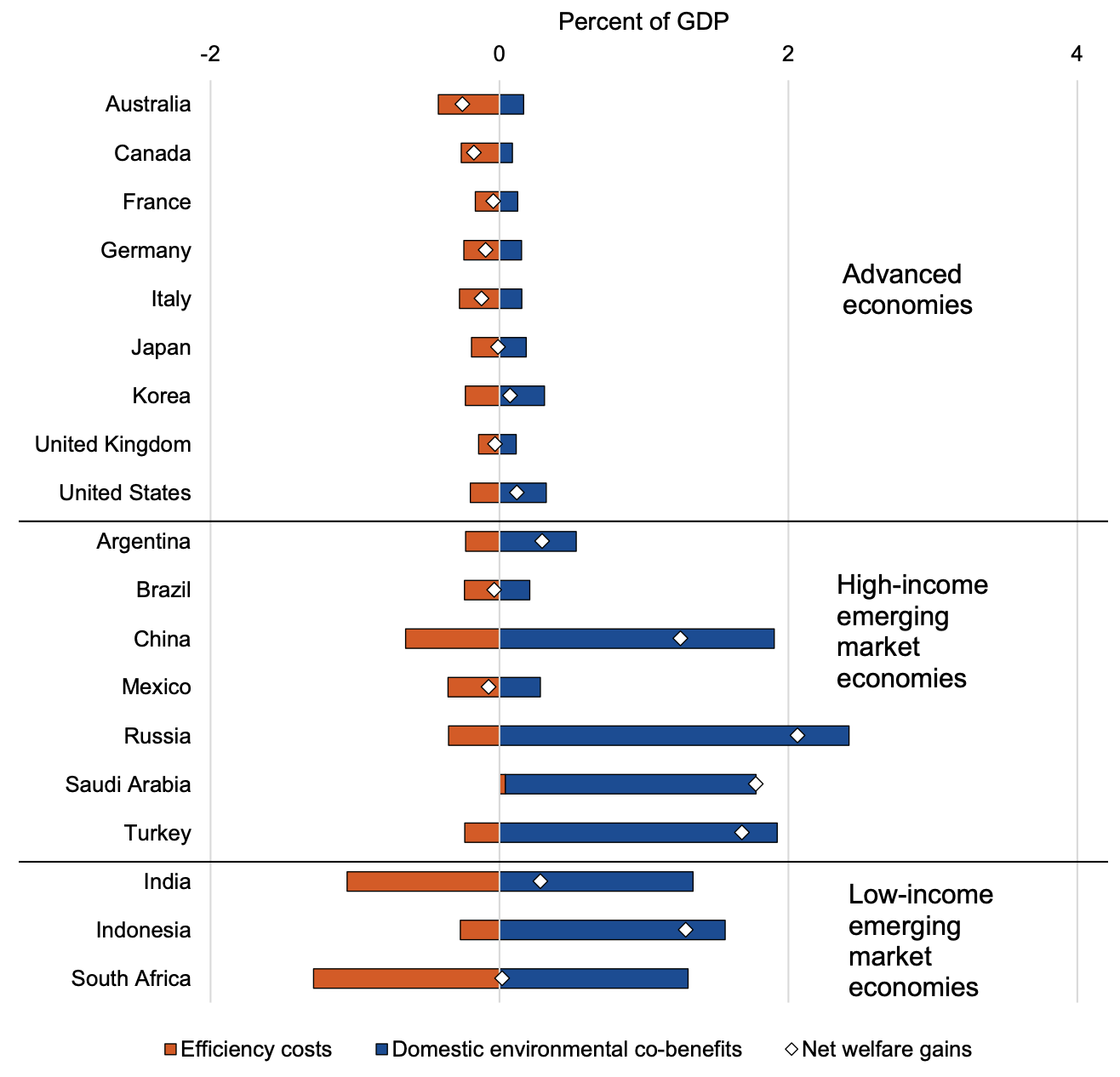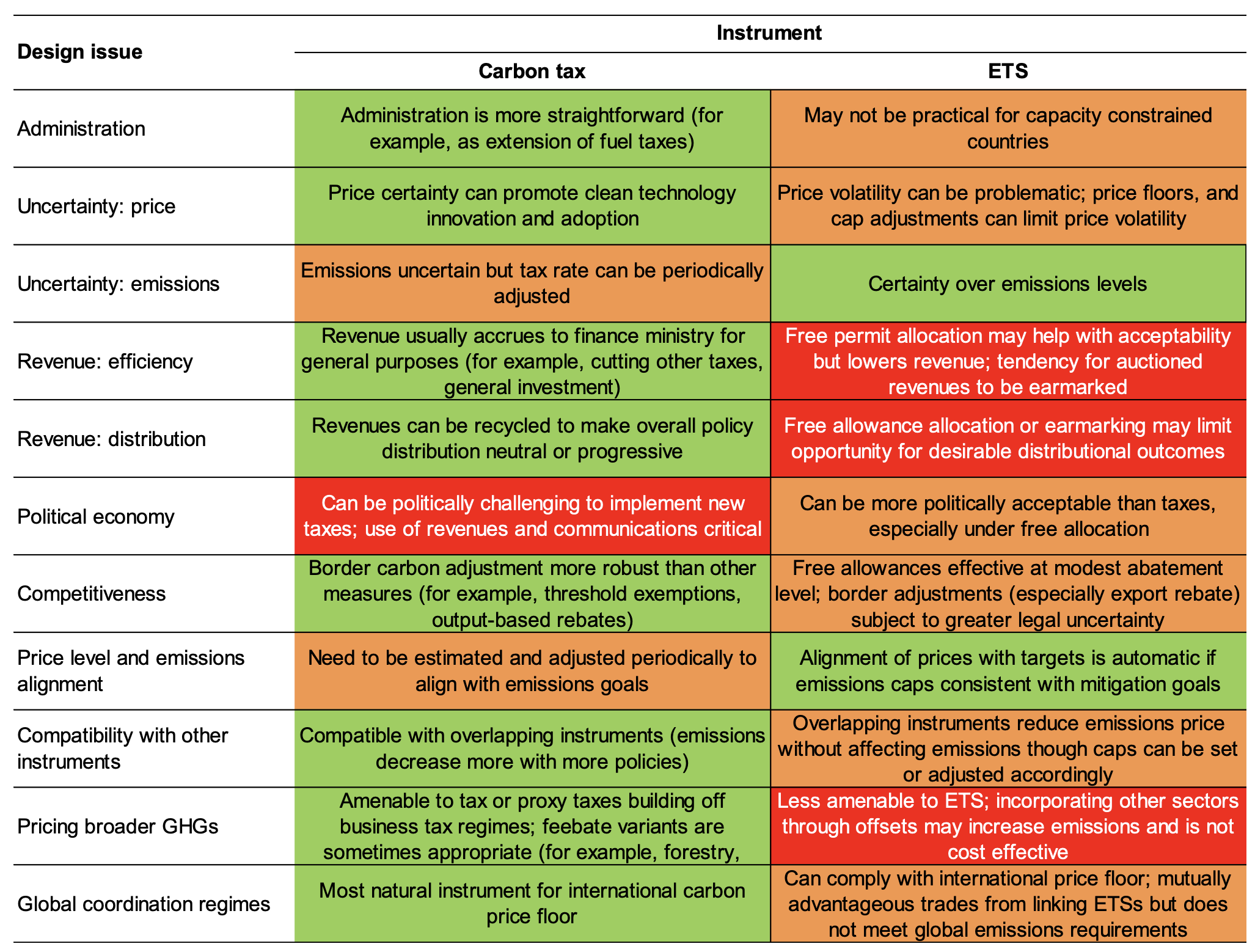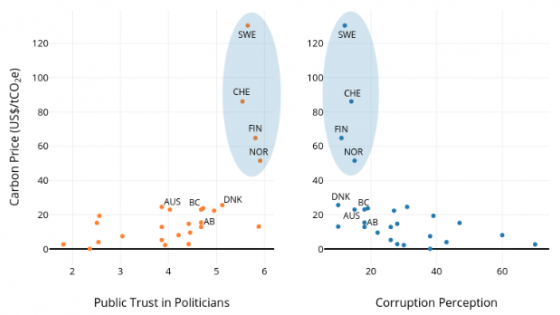Recent energy price shocks underscore the need to transition away from fossil fuels to address both the climate crisis and reduce dependency on insecure energy sources. Ideally, a central element of mitigation strategies is a carbon price that rises progressively over time – complemented by other mitigation policies to address particular sectoral issues.
Comprehensive carbon pricing promotes a full range of behavioural responses for reducing energy use and shifting to cleaner fuels across sectors, firms, and households. Carbon pricing can be implemented through carbon taxes, that is, charges on the carbon content of fossil fuels or through emissions trading systems (ETSs) requiring firms to acquire allowances for their emissions. In the latter case, the government controls the supply of allowances and market trading of allowances establishes the emissions price. As documented by the World Bank (2022), carbon pricing schemes are already operating in 45 countries and other countries are considering one (see Figure 1). Economic analysis is needed to guide the design of these schemes (Oswald and Stern 2019); in this column we discuss these issues drawing from a recent paper (Parry et al. 2022).
Figure 1 National or regional carbon pricing schemes globally, 2022
Sources: Parry and others (2022) and World Bank (2022).
Notes: EU ETS includes Iceland, Liechtenstein, and Norway. Prices are emissions-weighted averages between schemes at national, subnational and, if applicable, EU level. At present, China’s system takes the form of a tradable emissions intensity standard with no fixed cap on emissions. Value of pricing is the carbon price times emissions covered divided by GDP.
As well as accelerating decarbonisation, carbon pricing can also have significant fiscal and economic benefits. For illustration, a $50 carbon price in 2030 would cut CO2 emissions in individual Group of Twenty (G20) countries by around 15–25% below baseline levels.1 It would also raise annual revenues of about 0.5–2% of GDP. These revenues could be especially appealing in countries where revenue mobilisation from broader fiscal instruments is hindered by widespread informality. And the economic costs of a $50 carbon price (mainly the annualised costs of using cleaner but more expensive technologies) are manageable – around 0.1% to 0.6% of GDP. Indeed, the domestic environmental co-benefits of carbon pricing, most notably reductions in local air pollution mortality, substantially exceed mitigation costs in many cases – before even counting climate benefits (see Figure 2).
Figure 2 Economic costs and domestic environmental co-benefits from $50 carbon price, 2030
Source: Parry and others (2022).
Note: Domestic environmental co-benefits principally include reductions in local air pollution mortality but also and road congestion and accident externalities.
Comparing carbon taxes and ETSs
In their purest forms, ETSs provide certainty over emissions with carbon prices determined by market factors, and vice versa for carbon taxes. Certainty over emissions is attractive if policymakers want to meet a future emissions target. But the resulting price uncertainty may weaken incentives for private investment in clean technologies like renewables plants with high upfront costs and long-range emissions reductions.
In practice, however, both taxes and ETSs can balance uncertainly over emissions and prices, at least to some degree. In most carbon tax schemes, tax rates are fixed and adjusted on a discretionary basis according to progress on emissions goals, while ETSs may include price stability mechanisms like price floors. The latter mechanisms also improve the compatibility of ETSs with overlapping instruments like energy efficiency and renewables policies – otherwise, under a fixed emissions cap, these measures would lower allowance prices without affecting emissions.
In principle, carbon pricing should cover CO2 from the power, industry, transport, and buildings sectors, which account for the majority of emissions. In practice, pricing emissions from power and industry is the immediate priority. These sectors account for around 60% to 90% of the likely emissions reductions under comprehensive carbon pricing in G20 countries to 2030, for example.
Carbon taxes are generally under the purview of finance ministries and are straightforward to administer. They can be integrated into existing road fuel taxes and extended to other processed petroleum products, coal, and natural gas, or into fiscal regimes applied ‘upstream’ at the point of fuel extraction or import. ETSs, which are generally under the purview of environment ministries, are usually applied ‘downstream’ to large emitters in the power and industrial sector, though they could be applied ‘midstream’ to firms supplying transport and building fuels (as they are in California and Germany). New capacity is required for ETSs to monitor downstream emissions and trading markets though they may not be viable in countries with limited institutional capacity or where the allowance trading market would be concentrated and subject to manipulation.
There is much at stake in terms of economic efficiency and political economy in how potential carbon pricing revenues are used. Productive uses of revenues – such as lowering taxes on work effort or funding public investment – boost economic activity, counteracting the harmful effect of higher energy prices and potentially garnering political support from households. Most carbon tax schemes use revenue for these general purposes.
ETSs could raise similar fiscal benefits if allowances are auctioned, though especially in early phases allowances are often given away as ‘free allocations’ to garner support from affected industries. Where allowances are auctioned, revenues tend to earmarked for environmental spending.
As with all taxes, carbon taxes can be politically challenging to implement. However, their acceptability can be enhanced through revenue recycling, robust assistance for vulnerable groups, and inclusive and expansive communications strategies which include consultations with key stakeholders.
Allocation of revenues has critical implications for impacts on households. Carbon tax revenues can be recycled in ways that make the overall reform distributionally neutral, or progressive through, for example, combining general tax reductions with some targeted relief for low-income households. In this way for most countries, such reforms can be designed to be pro-poor, pro-equity, as well as pro-climate. By contrast, an ETS does not provide the same opportunities if allowances are freely allocated or if revenues are earmarked to environmental expenditures.
Competitiveness and ‘carbon leakage’ concerns arise for policymakers considering carbon pricing, specifically about the impacts of higher energy costs for trade exposed industries like steel, aluminium, and cement. For carbon taxes, some countries have exempted certain industries or fuels with gradual phaseouts. For ETSs, free allowances have been widely utilised. Both approaches, however, come with potential fiscal, economic, and environmental costs and are much less effective than alternatives, especially at higher levels of decarbonisation. A more robust measure, currently receiving much attention, is border carbon adjustments (BCAs) which impose charges for embodied carbon in imports, which could be matched by rebates for carbon embodied in domestic exporters. BCAs associated with domestic carbon taxes are probably somewhat easier to square with WTO requirements than BCAs associated with ETSs, especially for export rebates. However, these legal aspects have not yet been tested in practice.
For broader emissions sources beyond fossil fuel CO2, carbon taxes – or variants of them – may be more practical instruments than ETSs. For example, fees for methane emissions from coal, gas, and oil extraction can be integrated into existing tax regimes for these industries, potentially in a revenue-neutral way to address competitiveness concerns. In agriculture, where there is existing capacity for administering business taxes or assistance programmes, pricing might also be applied to methane from livestock based on farm outputs and inputs (for example, type of herd and feed) and default emissions factors. The forestry sector is potentially amenable to a fee-and-rebate (‘feebate’) regime, whereby fees paid by more carbon-intensive firms are used to fund subsidies to less intensive firms.
At the international level, agreements over minimum carbon prices (‘floors’) can address concerns about unilateral mitigation action including competitiveness and policy uncertainty in other countries. Price floor requirements can be readily met through carbon taxes since they represent fixed prices. But ETSs could also be accommodated by underpinning the domestic ETS with a floor price or by setting caps to generate expected domestic emissions prices (as they are under federal pricing requirements in Canada). To accommodate the principle of international equity embedded into the Paris Agreement (that developed countries cut emissions faster), price coordination regimes would need to differentiate requirements according to level of development, with higher prices in developed countries than developing countries.
In conclusion, designing and implementing policy packages that cut emissions while ensuring a just transition, ideally with carbon pricing at their core, will be key to achieving climate targets and, ultimately, the Paris Agreement.
Policymakers will choose between and within carbon pricing instruments depending on their diverse national circumstances. While there are many practical advantages of carbon taxes, policymakers may prefer ETSs for other reasons – for example, if mitigation policy is delegated to environment ministries or taxes face stiffer constitutional obstacles (for instance, unanimity rather than simple majority in the EU). In some ways ETSs can be designed to replicate attractions of taxes (e.g. through price floors and allowance auctions). In other cases, countries may choose to operate ETSs for energy while using tax schemes that build off existing revenue administration for broader emissions sources. Table 1 provides a summary of the issues that policymakers need to consider in designing carbon taxes and ETSs.
Table 1 Summary comparison of carbon taxes and ETSs
Source. Parry et al. (2022).
Note: Green indicates an advantage of the instrument; orange indicates neither an advantage nor disadvantage; red indicates a disadvantage of the instrument.
References
Oswald, A and N Stern (2019), “Why are Economists Letting Down the World on Climate Change?”, VoxEU.org, 17 September.
Parry, I, S Black, and K Zhunussova (2022), “Carbon Taxes or Emissions Trading Systems? Instrument Choice and Design”, IMF Staff Climate Note No 2022/006.
World Bank (2022), State and Trends of Carbon Pricing 2022.
Endnotes
1 Quantitative results here are from Parry et al. (2022).









